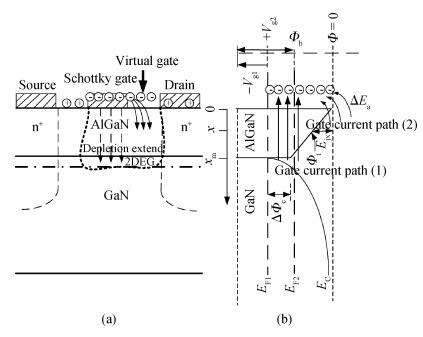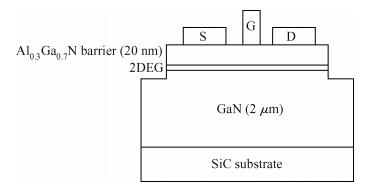| Citation: |
Yu'an Liu, Yiqi Zhuang. A gate current 1/f noise model for GaN/AlGaN HEMTs[J]. Journal of Semiconductors, 2014, 35(12): 124005. doi: 10.1088/1674-4926/35/12/124005
****
Y A Liu, Y Q Zhuang. A gate current 1/f noise model for GaN/AlGaN HEMTs[J]. J. Semicond., 2014, 35(12): 124005. doi: 10.1088/1674-4926/35/12/124005.
|
A gate current 1/f noise model for GaN/AlGaN HEMTs
DOI: 10.1088/1674-4926/35/12/124005
More Information
-
Abstract
This work presents a theoretical and experimental study on the gate current 1/f noise in AlGaN/GaN HEMTs. Based on the carrier number fluctuation in the two-dimensional electron gas channel of AlGaN/GaN HEMTs, a gate current 1/f noise model containing a trap-assisted tunneling current and a space charge limited current is built. The simulation results are in good agreement with the experiment. Experiments show that, if Vg < Vx (critical gate voltage of dielectric relaxation), gate current 1/f noise comes from the superimposition of trap-assisted tunneling RTS (random telegraph noise), while Vg > Vx, gate current 1/f noise comes from not only the trap-assisted tunneling RTS, but also the space charge limited current RTS. This indicates that the gate current 1/f noise of the GaN-based HEMTs device is sensitive to the interaction of defects and the piezoelectric relaxation. It provides a useful characterization tool for deeper information about the defects and their evolution in AlGaN/GaN HEMTs.-
Keywords:
- 1/f noise,
- gate leakage,
- AlGaN/GaN,
- HEMT
-
References
[1] Asgari A, Karamad M, Kalafi M. Modeling of trap-assisted tunneling in AlGaN/GaN heterostructure field effect transistors with different Al mole fractions. Superlattices and Microstructures, 2006, 40:603 doi: 10.1016/j.spmi.2006.07.023[2] Hasegawa H, Inagaki T, Ootomo S, et al. Mechanisms of current collapse and gate leakage currents in AlGaN/GaN heterostructure field effect transistors. J Vac Sci Technol B-Microelectronics and Nanometer Structures, 2003, 21(4):1844 doi: 10.1116/1.1589520[3] Del Alamo J A, Joh J. GaN HEMT reliability. Microelectron Reliab, 2009, 49:1200 doi: 10.1016/j.microrel.2009.07.003[4] Tartarin J G. Diagnostic tools for accurate reliability investigations of GaN devices. 21st International Conference on Noise and Fluctuations, 2011:452[5] Rao H, Bosman G. Study of RF reliability of GaN HEMTs using low-frequency noise spectroscopy. IEEE Trans Device Mater Reliab, 2012, 12(1):31 doi: 10.1109/TDMR.2011.2173497[6] Marko P, Meneghini M, Bychikhin S, et al. Noise and electroluminescence analysis of stress-induced percolation paths in AlGaN/GaN high electron mobility transistors. Microelectron Reliab, 2012, 52:2194 doi: 10.1016/j.microrel.2012.06.030[7] Kotchetkov D, Balandin A A. Carrier-density fluctuation noise and the interface trap density in GaN/AlGaN HFETs. Mat Res Soc Symp Proc, 2001:680[8] Han I K, Lee J I. Low frequency noise in HEMT structure. Journal of the Korean Physical Society, 2001, 39:S322[9] Katz O, Bahir G, Salzman J. Low-frequency 1/f noise and persistent transients in AlGaN-GaN HFETs. IEEE Electron Device Lett, 2005, 26(6):345 doi: 10.1109/LED.2005.848092[10] Rao H, Bosman G. Simultaneous low-frequency noise characterization of gate and drain currents in AlGaN/GaN high electron mobility transistors. J Appl Phys, 2009, 106:103712 doi: 10.1063/1.3259437[11] Rao H, Bosman G. Device reliability study of AlGaN/GaN high electron mobility transistors under high gate and channel electric fields via low frequency noise spectroscopy. Microelectron Reliab, 2010, 50:1528 doi: 10.1016/j.microrel.2010.07.073[12] Marko P, Alexewicz A, Hilt O, et al. Random telegraph signal noise in gate current of unstressed and reverse bias-stressed AlGaN/GaN high electron mobility transistors. Appl Phys Lett, 2012, 100:143507 doi: 10.1063/1.3701164[13] Karboyan S, Tartarin J G, Labat N, et al. Gate and drain low frequency noise of ALGAN/GAN HEMTs featuring high and low gate leakage currents. IEEE 22nd International Conference on Noise and Fluctuations (ICNF), 2013:1[14] Rendek K, Satka A, Donoval D. Measurement set-up for low-frequency noise characterization of GaN HEMT transistors. IEEE 22nd International Conference on Radioelektronika, 2012:1[15] Satka A, Rendek K, Priesol J. Relaxation of low-frequency noise in AlGaN/GaN HEMTs. IEEE Ninth International Conference on Advanced Semiconductor Devices & Microsystems (ASDAM), Smolenice, Slovakia, 2012:19[16] Kumar N, Kumar P, Kumar A. AlGaN/GaN HFET:operating principle and noise performance. International Journal of Advanced Trends in Computer Science and Engineering, 2013, 2(4):86[17] Tartarin J G, Karboyan S, Carisetti D, et al. Gate defects in AlGaN/GaN HEMTs revealed by low frequency noise measurements. IEEE 22nd International Conference on Noise and Fluctuations (ICNF), 2013[18] Xu W, Bosman G. Space charge limited current noise in AlGaN/GaN HEMTs. IEEE 22nd International Conference on Noise and Fluctuations (ICNF), 2013[19] Xu W, Rao H, Bosman G. Evidence of space charge limited flow in the gate current of AlGaN/GaN high electron mobility transistors. Appl Phys Lett, 2012, 100:223504 doi: 10.1063/1.4724207[20] Sudharsanan S, Karmalkar S. Modeling of the reverse gate leakage in AlGaN/GaN high electron mobility transistors. J Appl Phys, 2010, 107:064501 doi: 10.1063/1.3340826[21] Crupi F, Magnone P, Simoen E, et al. The role of the interfaces in the 1/f noise of MOSFETs with high-k gate stacks. ECS Trans, 2009, 19(2):87[22] Hasegawa H, Akazawa M. Current transport, Fermi level pinning, and transient behavior of group-Ⅲ nitride Schottky barriers. Journal of the Korean Physical Society, 2009, 55(3):1167[23] Vitusevich S A, Danylyuk S V, Kurakin A M. Origin of noise in AlGaN/GaN heterostructures in the range of 10-100 MHz. J Appl Phys, 2006, 99:0737061 -
Proportional views






 DownLoad:
DownLoad:

















